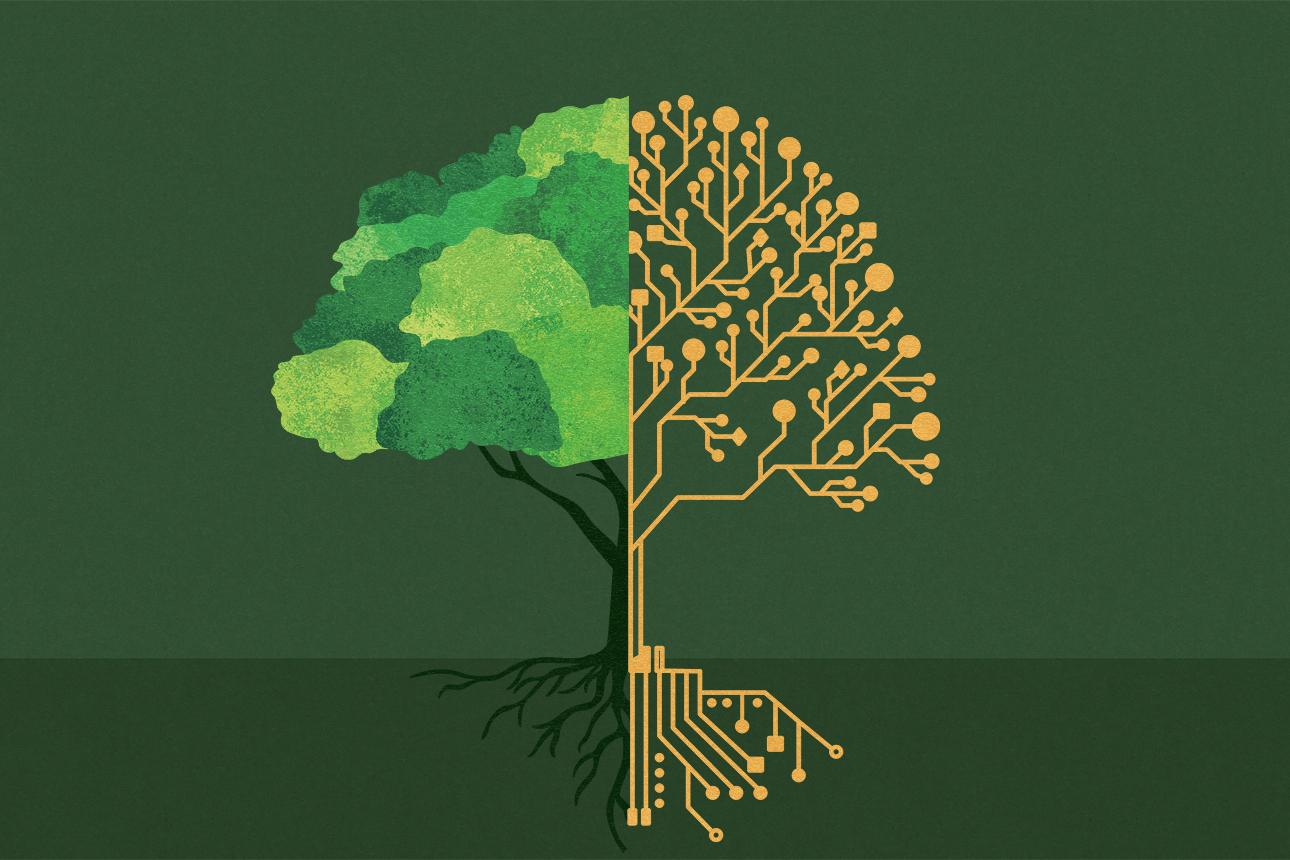Topics
Column
Our expert columnists offer opinion and analysis on important issues facing modern businesses and managers.
More in this series
Carolyn Geason-Beissel/MIT SMR | Getty Images
The proverbial ship of artificial intelligence is moving ahead at warp speed, icebergs and societal risks be damned. The pace of change in what it can do is staggering. Breathless predictions say AI will add trillions of dollars to the economy through massive cost savings and entirely new products and markets.
While the capabilities of AI, along with both excitement and fear, are exploding, it’s a good time to ask what AI might mean for the world’s serious challenges (climate change, inequality, threats to democracy, and more). Will it help us or hinder us … or both? What does AI mean for the quest for a more regenerative and net-positive world?
This could obviously be a book-length discussion, but let me focus on four big categories of impact — AI’s upside for helping on climate change and sustainability, its rising energy demands, the dangers of AI-enhanced misinformation, and its impact on people’s livelihoods — and provide a snapshot of where we are right now.
Get Updates on Leading With AI and Data
Get monthly insights on how artificial intelligence impacts your organization and what it means for your company and customers.
Please enter a valid email address
Thank you for signing up
1. AI Could Make the World and Business More Sustainable.
I wrote about the potential for AI to solve societal problems in 2018, but clearly what was once hype is fast becoming reality. Thanks to AI tools, we should see dramatic improvements in the management of our biggest systems: climate and emissions, energy and the grid, transportation, water, food and agriculture, buildings and cities, and more. Better modeling and more transparency into operations should help businesses and governments slash emissions (with a huge caveat, discussed in Point 2 below).
Here are some key examples of where AI is being used in positive ways. These benefits are generally coming from traditional AI rather than flashy generative AI chatbots and tools, but the distinction may be blurring, and both are developing capabilities at breathtaking speeds:
- Energy use — optimizing building design and controls, which the U.S. Department of Energy estimates can reduce a site’s energy consumption by 29% or more.
- Energy and grid management — balancing supply and demand on the grid, by managing the extreme complexity of a billion things drawing power, millions of things (as wide-ranging as rooftop solar panels and giant power plants) generating power, and some things doing both (such as electric vehicles drawing power for part of the day and, at other times, acting as mobile batteries feeding the grid).
- Food and agriculture — supercharging “precision agriculture,” which can boost farm efficiency 20% to 40% through better weather prediction and more precise application of water, fertilizer, or pesticides. AI tools are also being used to help reduce the shocking waste of food (an estimated 30% to 40% is thrown out in the U.S. alone), saving enormous quantities of embedded carbon and water.
- Logistics and transportation — improving traffic flows, reducing idling, and slashing the number of accidents.
- Supply chains — lowering risk, costs, waste, and inventory through better forecasting and management.
- Product design — creating products with lower life-cycle impacts.
And on the social side of the sustainability agenda and human well-being:
- Health care — accelerating drug discovery and disease detection. For instance, the Mayo Clinic used AI to reduce the time it takes to identify a form of kidney disease from 45 minutes to seconds.
- Education — personalizing learning and making wider access more feasible.
- Public safety — providing better predictions of crime patterns and natural disasters fueled by climate change.
- Inclusion — enhancing assistive technologies for people with disabilities.
On a tactical level, there’s also great hope that AI will help companies respond to significantly expanding reporting demands, such as gathering data and filling out seemingly infinite numbers of forms. Clearly, the list of possible benefits is long, and I admit I hadn’t thought of a couple of these on the social side. (Thanks, ChatGPT, for suggesting disaster preparedness and inclusion.)
2. AI Is Contributing to Mushrooming Energy Use.
The Financial Times reported in May that AI data centers in the U.S. already demand 15 gigawatts (GW) of power annually — or about the capacity of all U.S. solar farms. The International Energy Agency estimates that by 2026, global data center electricity needs will be more than double 2022 levels, equaling Japan’s current total electricity consumption.
It’s not clear whether the utilities can keep up — growth in power hinges on quickly siting, permitting, and building enough data centers and power plants, despite local resistance. For example, U.S. utility Georgia Power’s growth estimate for its fleet of power plants skyrocketed from a January 2022 forecast of 0.4 GW of additions by 2030 to an October 2023 forecast of 6.6 GW by 2030. Utilities have, at times, exaggerated demand to justify more building (especially of nonrenewable projects), but that kind of scale remains daunting: Even if Georgia Power built a copy of the world’s largest solar farm (7 million panels) and added three typical nuclear reactors, it would still fall short of its goal of 6.6 GW. And that’s just the projection in one U.S. state.
Even if a power buildout happens, it’s a mixed bag. Growth in utility capacity could undercut the tremendous progress the energy and tech sectors have made on cutting carbon emissions. Trane Technologies (a client of mine) helps data centers stay cool, so it should be thrilled with the growth. But the company is also worried about what new demand means for its efforts to help customers cut emissions by 1 gigaton by 2030. “The AI boom has triggered significant power and cooling demands,” said Paul Camuti, Trane’s executive vice president and chief technology and sustainability officer. “We have an urgent need for innovation in renewable energy, storage, and demand-side efficiency on a large scale — all at the pace needed to avoid creating significant obstacles to sustainability.” In other words, the growth could outpace all the efficiency work Trane and others have been doing.
Grid reliability could suffer if power generation can’t keep up. Grid limitations could hamper the shift to “electrify everything” — that is, the adoption of electric vehicles and grid-only-powered buildings and factories. Efforts to decarbonize key sectors and the grid, which the world so desperately needs, might be overwhelmed by the rush to build all forms of energy.
Utility growth could undercut the tremendous progress the energy and tech sectors have made on cutting carbon emissions.
The projected growth in energy demand, amid the urgent need to cut emissions, should give us pause. Indeed, it’s already causing tech companies to badly miss their climate goals — both Microsoft and Google announced recently that their emissions have gone way up in the last four years. And yet, there’s hope. The tech giants are already the largest buyers of renewable energy. Microsoft, for example, is trying to add primarily renewable energy to the grid and is investing heavily in carbon sequestration, which the U.S. Geological Survey defines as the process of capturing and storing atmospheric carbon dioxide. And the tech giant is doing more: “Our commitment to have our business powered 100% of the time by 100% zero-carbon energy by 2030 is also guiding our work on utility-scale battery storage, grid transformation, and environmental justice,” said Michelle Lancaster, Microsoft’s senior director of global strategy.
As much as possible, the big guys say they want to remain carbon neutral even as they increase power use. They’re not succeeding at the moment, but it may be possible, based in part on past experience. Maud Texier, Google’s global director of clean energy and decarbonization development, recently noted that while the company’s data center volume grew 550% between 2010 and 2018, its energy use increased by only 6%, thanks in part to AI-driven efficiency. In 2016, Google’s DeepMind AI reduced one data center’s cooling energy use by up to 40%, resulting in a 15% reduction in power usage effectiveness overhead overall. AI could also make the whole grid more efficient. All that said, it’s going to be a tough race with radical demand growth.
Finally, outside of the specific question of data center energy needs, AI can make the things that already produce climate-changing emissions worse. The fossil fuel industry uses AI to find more resources; fast fashion companies use it to identify more niche markets and produce more short-lasting apparel; and AI can help fishing companies overfish the oceans even more quickly.
3. AI Is the Source of Both Information and Dangerous Misinformation.
The benefits of AI come from more and better data about systems. AI can uncover patterns, give us a new understanding of how things work, and then optimize systems. But this information reflects the world as it is, not how we’d like it to be. It has bias. Amazon once discovered that its AI-driven hiring system was biased against female applicants because most current job holders were men. In other cases, algorithms in the criminal justice and health systems have revealed built-in stereotyping.
What can be done to stop intentional, weaponized misinformation created by generative AI?
The tech world is developing ways to avoid bias, and let’s assume that the AI gods can help reduce this unintentional risk. But what can be done to stop intentional, weaponized misinformation created by generative AI? With more than 2 billion people voting globally this year in contentious elections where democracy is on the ballot, AI-created fake content is already confusing people. In January, a deepfake robocall created to sound like President Joe Biden encouraged voters in New Hampshire to skip the primary. It seemed like a test run for much worse.
4. AI will have unknown, large impacts on jobs and livelihoods.
I was recently blown away by the newest addition to the ChatGPT arsenal, Sora, which turns text prompts into high-quality movies that are nearly indistinguishable from human-made live-action or animated films. My first reaction beyond pure awe was to wonder whether a studio would need to build real sets anymore. Indeed, after seeing Sora, uber-producer Tyler Perry paused plans for an $800 million studio expansion at his Atlanta compound, telling The Hollywood Reporter, “If I wanted to have two people in the living room in the mountains, I don’t have to build a set in the mountains, I don’t have to put a set on my lot. I can sit in an office and do this with a computer, which is shocking to me.”
If you’ve ever sat through the credits for a Marvel movie, you’ve seen how many people work on these giant films. You don’t have to be a Luddite to wonder what happens to those jobs. Of course, there is a possible wonderful upside: If AI democratizes filmmaking and nearly anyone is able to make a movie, maybe the world will discover Steven Spielbergs and Greta Gerwigs anywhere — from the favelas of Rio to the farming communities of rural India.
This is just one industry’s example; the implications of AI extend through every sector and job type. The tech companies highlight the potential growth of new jobs, but as comedian Jon Stewart recently pointed out, the new job of “AI prompt engineer” may really be “types question guy”— and, he added, “if there’s any kind of job that can be easily replaced by AI, it’s ‘types question guy.’” McKinsey predicts that AI will help automate 30% of work hours in the U.S. by 2030. Does that mean more productivity or fewer jobs? Who knows.
We may have to think about how to adapt society to these profound changes. Some Silicon Valley bigwigs (including OpenAI’s CEO Sam Altman) have been advocating for a universal basic income — that is, a payment to every citizen to ensure that they have enough money to survive. Seems like these leaders know something about what their technologies will mean for all of us.
So, what’s the bottom line? Even putting aside the extreme downside of “AI tries to kill us all” — which appears so often in science fiction because it rings true — there are plenty of concerns. The loss of jobs could be unprecedented, as could the rising demand for energy, which could drive carbon emissions much higher, potentially offsetting a large portion of the world’s efforts to control climate change.
Like so many new technologies, AI is finding its way into flashy uses in entertainment and productivity. Behind the scenes, the real potential to improve our biggest systems seems very high. Will the benefits outpace the resource use and dangers to society? Maybe — but only, I think, if we are clear-eyed about the challenges and collectively make it a goal to address the downsides head-on. Will we focus this unimaginably powerful tool in the right way to save ourselves? That’s up to us … for now.
“The MIT Sloan Management Review is a research-based magazine and digital platform for business executives published at the MIT Sloan School of Management.”
Please visit the firm link to site




